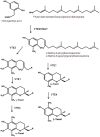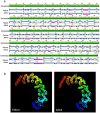Comparative systems biology reveals allelic variation modulating Tocochromanol profiles in Barley (Hordeum vulgare L.)
- PMID: 24820172
- PMCID: PMC4018352
- DOI: 10.1371/journal.pone.0096276
Comparative systems biology reveals allelic variation modulating Tocochromanol profiles in Barley (Hordeum vulgare L.)
Abstract
Tocochromanols are recognized for nutritional content, plant stress response, and seed longevity. Here we present a systems biological approach to characterize and develop predictive assays for genes affecting tocochromanol variation in barley. Major QTL, detected in three regions of a SNP linkage map, affected multiple tocochromanol forms. Candidate genes were identified through barley/rice orthology and sequenced in genotypes with disparate tocochromanol profiles. Gene-specific markers, designed based on observed polymorphism, mapped to the originating QTL, increasing R2 values at the respective loci. Polymorphism within promoter regions corresponded to motifs known to influence gene expression. Quantitative PCR analysis revealed a trend of increased expression in tissues grown at cold temperatures. These results demonstrate utility of a novel method for rapid gene identification and characterization, and provide a resource for efficient development of barley lines with improved tocochromanol profiles.
Conflict of interest statement
Figures





Similar articles
-
Quantitative Trait Loci Associated with the Tocochromanol (Vitamin E) Pathway in Barley.PLoS One. 2015 Jul 24;10(7):e0133767. doi: 10.1371/journal.pone.0133767. eCollection 2015. PLoS One. 2015. PMID: 26208213 Free PMC article.
-
DNA polymorphisms and haplotype patterns of transcription factors involved in barley endosperm development are associated with key agronomic traits.BMC Plant Biol. 2010 Jan 8;10:5. doi: 10.1186/1471-2229-10-5. BMC Plant Biol. 2010. PMID: 20064201 Free PMC article.
-
Expression genetics and haplotype analysis reveal cis regulation of serine carboxypeptidase I (Cxp1), a candidate gene for malting quality in barley (Hordeum vulgare L.).Funct Integr Genomics. 2006 Jan;6(1):25-35. doi: 10.1007/s10142-005-0008-x. Epub 2005 Nov 10. Funct Integr Genomics. 2006. PMID: 16283224
-
Construction and application for QTL analysis of a Restriction Site Associated DNA (RAD) linkage map in barley.BMC Genomics. 2011 Jan 4;12:4. doi: 10.1186/1471-2164-12-4. BMC Genomics. 2011. PMID: 21205322 Free PMC article.
-
Molecular dissection of a dormancy QTL region near the chromosome 7 (5H) L telomere in barley.Theor Appl Genet. 2003 Aug;107(3):552-9. doi: 10.1007/s00122-003-1281-5. Epub 2003 May 8. Theor Appl Genet. 2003. PMID: 12736778
Cited by
-
Genetic variation of HvXYN1 associated with endoxylanase activity and TAX content in barley (Hordeum vulgare L.).BMC Plant Biol. 2019 Apr 30;19(1):170. doi: 10.1186/s12870-019-1747-5. BMC Plant Biol. 2019. PMID: 31039733 Free PMC article.
-
Vitamin E Biosynthesis and Its Regulation in Plants.Antioxidants (Basel). 2017 Dec 25;7(1):2. doi: 10.3390/antiox7010002. Antioxidants (Basel). 2017. PMID: 29295607 Free PMC article. Review.
-
Quantitative Trait Loci Associated with the Tocochromanol (Vitamin E) Pathway in Barley.PLoS One. 2015 Jul 24;10(7):e0133767. doi: 10.1371/journal.pone.0133767. eCollection 2015. PLoS One. 2015. PMID: 26208213 Free PMC article.
-
Genetic variations of HvP5CS1 and their association with drought tolerance related traits in barley (Hordeum vulgare L.).Sci Rep. 2017 Aug 11;7(1):7870. doi: 10.1038/s41598-017-08393-0. Sci Rep. 2017. PMID: 28801593 Free PMC article.
References
-
- Schultz G, Soll J, Fiedler E, Schulze-Siebert D (1985) Synthesis of prenylquinones in chloroplasts. Physiol Plant 64: 123–129.
-
- Kamal-Eldin A, Appelqvist L-Å (1996) The chemistry and antioxidant properties of tocopherols and tocotrienols. Lipids 31: 671–701. - PubMed
-
- Azzi A, Stocker A (2000) Vitamin E: Non-antioxidant roles. Prog Lipid Res 39: 231–255. - PubMed
-
- Munné-Bosch S, Alegre L (2002) The function of tocopherols and tocotrienols in plants. Crit Rev Plant Sci 21: 31–57.
-
- Munné-Bosch S, Falk J (2004) New insights into the function of tocopherols in plants. Planta 218: 323–326. - PubMed
MeSH terms
LinkOut - more resources
Full Text Sources
Other Literature Sources

